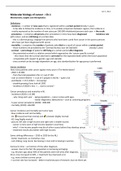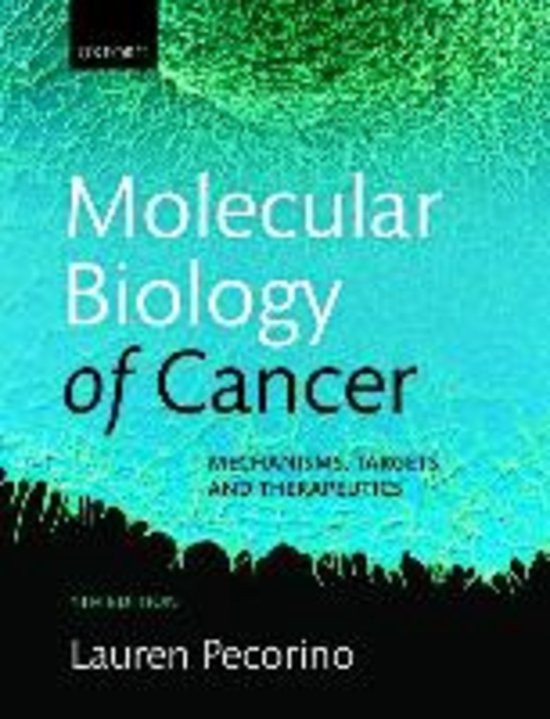HC 1, 29-3
Molecular biology of cancer – Ch.1
Mechanisms, targets and therapeutics
Definitions
- incidence -> number of new cases that is registered within a certain period (mostly 1 year).
- to be able to follow the incidence in time, or to enable comparison between regions, the incidence is
mostly expressed as the number of new cases per 100.000 inhabitants/persons each year -> the crude
- prevalence -> comprises all persons who somewhere in time have been diagnosed incidence rate
with cancer, and are still living at a certain date.
- this is a diverse group, ranging from persons who have been cured from cancer in the past to persons
who have just been diagnosed with cancer.
- mortality -> comprises the number of patients who died as a result of cancer within a certain period.
- those numbers are provided by the ‘Centraal Bureau voor de Statistiek’. (mostly 1 year)
- survival -> percentage of patients still living at a certain period after diagnosis.
- the presented survival is a relative survival which approaches the ‘cancer-specific survival’.
- this means that the survival observed is corrected for the expected death within the Dutch population
comparable with respect to gender, age and calendar.
- since survival can be strongly dependent on age, also standardization for age-group is performed.
Cancer incidence
How many patients with cancer appear every year in The Netherlands?
- 2020: 115.000
- from the total population this is 1 out of 150.
- over an entire lifetime -> 1 out of 3 people in the NL – quite a lot
- worldwide: ± 17,5 million – increasing!
- steadily growing if you look all 2020.
- incidence of 2020 is less -> …. due to corona?
Cancer prevalence and mortality in NL
- incidence (2020): 115.000
- why rising each year: - aging population – cancer comes with ages.
- better diagnostics (detections) – such as screening programs.
- 5-year cancer prevalence (2020): >380.000
- mortality (2019): ±46.000
Cancer incidence and mortality per tumor type
- blue incidence and red mortality
- #1: breast (not that mortal) and prostatic (highly mortal)
- #2: lung (highly mortal)
- picture: left side is high-income and right side is middle income.
- cancer is more seen in high income (western countries).
- why? -> low income people may die of other causes before they develop cancer.
- treatment results also better with high-income.
Some striking differences – 2010 vs 2020 (in the NL)
- better treatment, so mortality is less.
- sub striking, lung cancer decreasing in men and increasing in women.
Survival in time – as function of time after diagnosis
- answer: due to the fact the population is increasing and aging.
- e.g. 60 years ago about 40% of the patients were still alive after diagnosis,
this is now increased to 60% -> treatment has improved a lot.
- e.g. more children survive cancer.
-> survival rate has increased – better results because of research, but not there yet.
,Cancer mortality trends – 2000 vs 2010 (interesting)
- stomach cancer -> decreases
- for both men and women.
- due to better food preservation.
- lung cancer -> decreasing for men and increasing for women.
- men stopped smoking, while women started smoking a later age.
- increase of mortality by -> oesophagus, pancreas and melanoma
- might be related to: oesophagus – alcohol drinking, pancreas – unknown and melanoma – sun exposure.
What is cancer?
What is the clinical definition of cancer?
- cancer -> group of diseases – more than 100 cancer types can be distinguished.
- prognosis and treatment are different for each type.
- or even every tumor is different? – because every person is different (background can have influence)
- uncontrolled cell growth.
- grows invasive and forming metastases.
Has a patient with a tumor always cancer? -> NO
- a tumor is a mass of cells.
- not every tumor is invasive and metastasising.
- benign tumor are no cancer, only malignant tumors are cancer.
Why is a malignant tumor life threatening?
- invasion of organs disturbs organ function.
- cancer cells compete with normal cells for nutrients and oxygen.
- growing tumors can cause obstructions.
-> sometimes a combination which can lead to death.
What is the difference between carcinoma, adenocarcinoma, sarcoma and lymphoma?
- carcinomas -> arise from epithelia – ±85% of all cancers.
- why so high? Epithelia forms the outer surface of the body and also the digestive system, and these are
- carcinogens -> agents that cause cancer. exposed to carcinogens.
- adenocarcinomas -> arise from glandular tissue – e.g. breast.
- sarcomas -> arise from mesodermal tissue – e.g. bone and muscle.
- lymphomas -> arise form (progenitors of) white blood cells.
(the names are releated to the tissue from which the cancer arises/develops)
What is a carcinogen?
- carcinogen -> an agent causing cancer.
- causes alternations in the DNA of a cell.
- cancer cells contain many alterations in the DNA.
- the accumulation of mutations in the DNA of a cell causes stepwise development of cancer -> carcinogenesis
or oncogenesis.
Development of cancer -> oncogenese
Cancer is diagnosed by pathologists.
- how: recieve a biopsy of the supsected tissue -> under the microscope -> normal or not.
- now a days we can categorize tumor progression not only by histological evaluation, but also by molecular
markers (alterations by chromosomes or gene expression).
- also: the progress of the disease.
- stages: normal epithelium -> hyperplasia -> dysplasia -> carcinoma in situ->
invasive carcinoma (can metastasize) -> lymph node and distant metastases.
- multiple chromosomal mutations which are found in different stages in
development, in the end it is cancer (when it starts to invade).
- first mutation e.g. due to exposure to carcinogens.
,How we think cancer arises and progresses.
1. normal cell is hit by carcinogens -> tumor cell arises.
- cancer is clonal, it all starts as a single cell.
2. cell growth and division -> new DNA abberations (‘afwijking’) arise.
- tumors are heterogeneous.
- different mutations in the daughter cells.
Cancer is a disease of the genome
Is cancer inheritable?
- No. Almost all of the mutations developed in somatic cells and will not be passed to the next generation
- However, some inheritant germline mutations can increase the chance to develop of offspring.
cancer and can be passed on the next generation of offspring.
- these mutations are rarely involved in causing cancer immediately, it mostly an increased risk.
Why does the risk to develop cancer increase at older age?
- an accumulation of mutations in the DNA is needed for the development of cancer.
- it is a matter of chance and time (exposure to carcinogens).
- the incidence of cancer is increasing due to longer life expectancy.
Main characteristics of cancer
‘Hallmarks of Cancer’ -> cancer cells differs form normal cells.
- defined by Hanahan & Weinberg.
- important: - acurate diagnosis.
- selective and effective treatment.
- more detail at the end of this HC.
- every ‘halmark’ is a potential target for ‘selective therapy’
- drivers of malignancy, proliferation, invasion and metastasising.
- attractive to develop therapeutics that interfer with these proceses.
Characteristics of cancer
- a tumor is more than just tumor cells.
- consits of: - stromal cells – fibroblasts and immune cells.
- bloodvessels – supply of oxygen and nutrients.
- each of the components can also be targeted for therapy.
-> tumor micro environment
, The growth of a tumor
Disturbed balance between proliferation, cell death (apoptosis) and differentation.
- in a cancer this is permanent (e.g. temporarily with wound healing).
- stimulation of prolifation.
- loss of apoptosis.
- loss of differentation.
-> in most cases all three proceses are disturbed.
Oncogenes and tumor supressor genes
- oncogenes -> drivers for proliferation.
- supressor genes -> inhibitors of proliferation.
What are oncogenes?
- normal cell genes induced for expression by mutations.
- such genes are called proto-oncogenes.
- sometimes arise from a virus (or a carcinogen).
What is needed for a tumor supressor gene to allow tumor development?
- tumor suppressor genes protect against cancer.
- normally they prevent replication of DNA damage.
- tumor suppresor genes have to lose function -> loss of growth inhibition.
Crucial – how many mutations are minimally needed to activate a proto-oncogene or to inactivate a tumor
- every healthy cell has two copies of a gene. suppresor gene?
- a mutation of an oncogene is dominant -> 1 mutations is sufficient (to cause a tumor cell)
- a mutation in a tumor suppesor gene is recessive -> both alleles have to be mutated (most of the time).
- an exception form haploinsufficiency -> 1 mutation is sufficient.
- product is not sufficient for growth inhibition.
Characteristics of cancer cells
A lot of cancer research is done in vitro, cancer is also malignant in tissue culture (in glass).
Is it possible to recognize cancer cells in tissue culture?
- cancer cells have a different morphology – more rounded up.
- cancer cells can grow at low serum in cultur media – don’t need growth stimuli such as growth factors.
- cancer cells show no/decreased contact inhibition – cells grow confluently and up in layers -> colonies.
- cancer cells can grow without substrate for attachment – potential to disseminate by the bloodstream.
How can oncogenes be identified in a laboratory?
- isolation of the gene from tumor cells.
- transfection of DNA into immortalized mouse fibroblasts – grow like normal cells.
- evaluation whether transfected cells obtain altered growth characterics -> transformation assay.
- how: rounding up, grows out serum and grow up.
- colonie is a malignant behavior of cancer.
Factors playing a role in development of cancer
- environment – e.g. soot, sunlight (e.g. melanoma) and asbestos.
- diet and exercize – e.g. fuit, vegetables and fish.
- obese patients have a higher risk of getting cancer.
- alcohol – head and neck, breast (dominant factor)
- smoking – >80 carcinogenes and 40% of all cancer deaths.
- most dominant factor, but doesn’t only influence the lung epithelium.
- reproductions, contraception and hormone replacement therapy.
- viruses – sexual transmittable (e.g. HPV).
- own metabolism – by-product of metabolism and errors in DNA replication.
- e.g. Kaposi sarcoma (skin cancer) more in South Africa, why? It’s caused by HIV, more over there.






